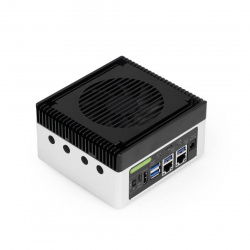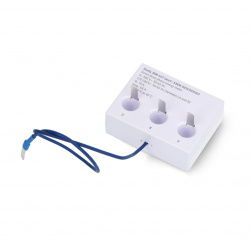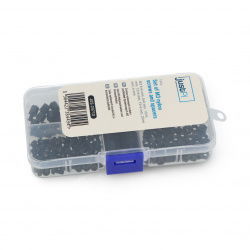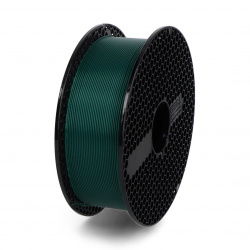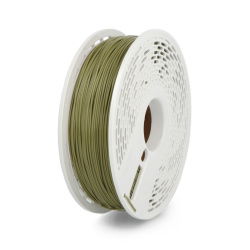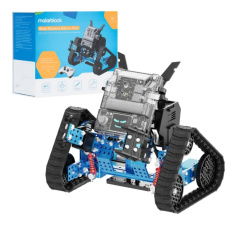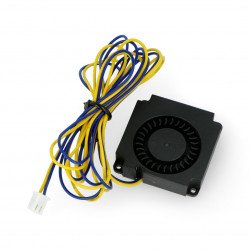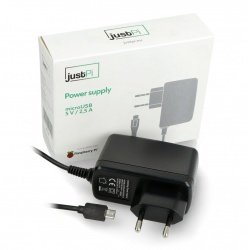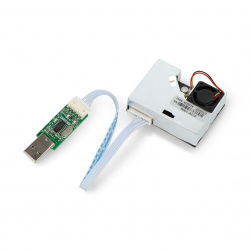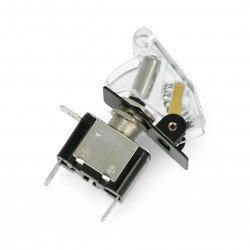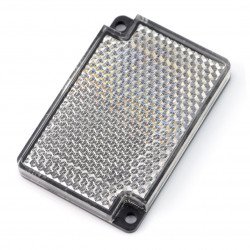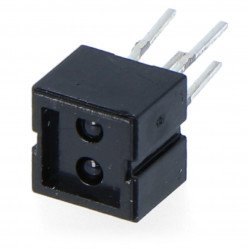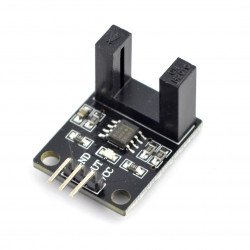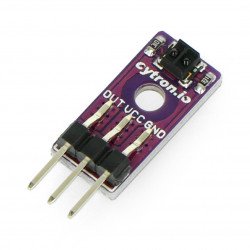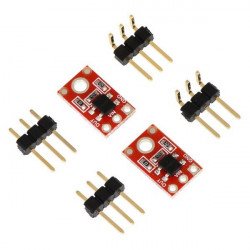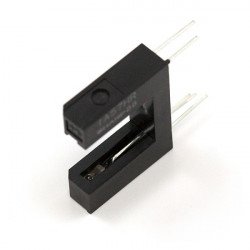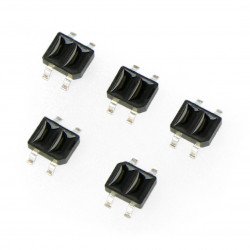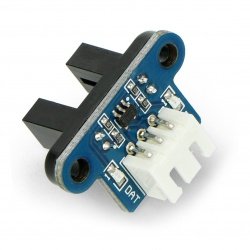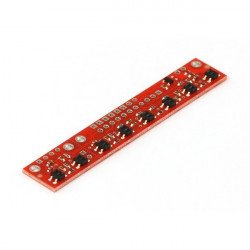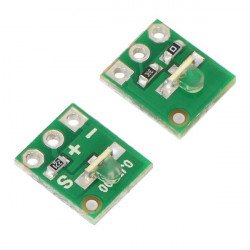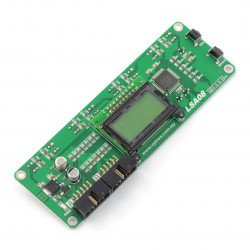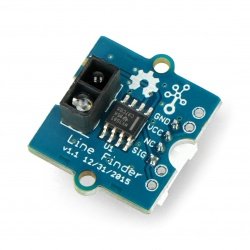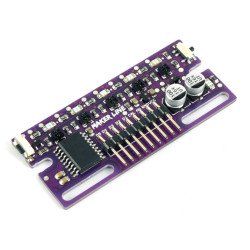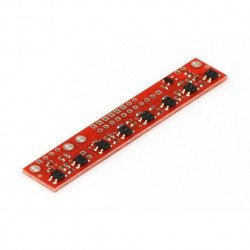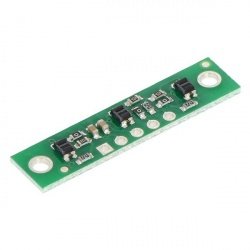There are many types of sensors used in automation and robotics. Gas sensors, light sensors, touch and motion sensors – these are just some of the types, probably the most popular ones. However, one of the most interesting modules extending a given project with a number of new functions are reflection sensors.
Sensors odbiciowe
Reflector for photoelectric sensor 6x4cm
Reflector for photoelectric sensors. The size of the refelector - 40 x 60 x 8 mm.CNY70 reflective optocoupler sensor
Reflective optocoupler used, for example, to distinguish the edges or for line detection. Case dimensions - 7 x 7 x 6 mm,through hole installation.Optical sensor with LM393 comparator - 10mm
Digital module with optical sensor, with a slit of 10 mm. The module has a built-in LM393 comparator because the output is a digital signal. The supply voltage is 5 V. Along...TCST1103 photoelectric sensor - optocoupler
Slit width: 3 mm. Maximum voltage - 70 Volts .Cytron Maker Reflect - Analog IR reflectance sensor
Maker Reflect is a small reflective sensor equipped with an IR diode that sends out an infrared light beam, which returns to the sensor after reflection from the surface and...QTR-1A reflectance sensor - 2pcs. - Pololu 2458
Two modules with QTR reflective sensors. They have an analog output. The supply voltage is 5 V.Slot sensor - optocoupler GP1A57HRJ00F - SparkFun SEN-09299
Sensor with an infrared emitter on one side and a screen infrared detector on the other. By emitting a beam of infrared light, it can detect when an object passes between the...KTIR0711S reflective optocoupler sensor - 5pcs
Reflective optocoupler used, for example, to distinguish the edges. The system is closed in a small, surface soldered case with dimensions: 2.7 x 3.4 mm. Items are sold in...Photo Interrupter Sensor, Speed Measuring - Waveshare 12225
Digital module with optical sensor, with a gap of 6 mm. The module has a built-in comparator, because of this, the output is a digital signal. Supply voltage is from 3.3 V to 5...QTR-8A reflectance sensor array- analog - Pololu 960
Strap of the eight reflecting sensors with analog outputs. It is powered with the voltage of 5 V or 3.3 V.Reflectance sensorQTR-L-1A - analog (2 pcs) - Pololu 2454
Module with reflective sensor basing on the transmitting LED and phototransistor operating in the infrared range. The sensor is powered with the 5V voltage. The output is an...DFRobot Gravity - line tracking sensor - reflective, digital
Digital sensor of tracking the line, reflective for Arduino, it can detect the white and black lines. Separate signals provides a stable output signal TTL, so it looks for more...SPDT E3JK-R4M1 90-250VAC photoelectric sensor IP65 NC / NO - 4m
Photoelectric transmitting sensor. It detects the objects by the method of reflection. Detection range is up to 4 meters. It has Light-ON operation mode. It is powered with the...Cytron LSA08 - strip with reflection sensors and display
Compact strap with eight reflective sensors. It has the function of automatic calibration, LCD display of 2x8, digital and analog outputs, UART, powered with a voltage of 12 V.VCNL4010 - distance and light sensor 20cm I2C - Adafruit 466
A digital sensor measuring the distance ranging up to 20 cm and the intensity of the incident light. It communicates via the I2C bus (TWi), it works with a voltage of 3.3 V and...- Reduced price
- SPECIAL OFFERS
Photoelectric sensor SPDT E3JK-R4M1 12V IP65 - 4m
Photoelectric transmitting sensor. It detects the objects by the method of reflection. Detection range is up to 4 meters. It has Light-ON operation mode. It is powered with...Grove - RS-06WD reflectance sensor v1.1
Module from the Grove is equipped with the reflective sensor RS-06WD. It consists of LED emitting the infrared light and phototransistor of high sensitivity. It is supplied...Proximity and light sensor - VCNL4020 - STEMMA QT/Qwiic - Adafruit 5810
The module from Adafruit equipped with the VCNL4020 system, with the ability to measure light intensity in the range from 0.26 lux to 16,000 lux . The sensor also allows you...QRE1113 - analog reflectance sensor - SparkFun ROB-09453
Analog sensor that has capability of detecting the line. Detects light reflected from the surface and on its basis determines the color of the surface. The module has an analog...VCNL4040 - Proximity Sensor Breakout - 20cm (Qwiic) - SparkFun SEN-15177
A digital sensor that combines the ability to measure proximity IR and measure the intensity of ambient light. The module allows to detect obstacles in the range of 0 to 20 cm....Cytron Maker Line -Trim with reflective sensors
The Cytron module equipped with 5 reflective sensors (pair : IR diode and phototransistor) is able to track 13 to 30 mm wide lines in white and black. The sensor has 2...QTR-8RC reflectance sensor array - digital - Pololu 961
Strap with eight reflective sensors with digital output. It is powered with the voltage of 5 V or 3.3 V.Trim with QTR-3A reflective sensors - analog - Pololu 2456
Compact bar with three reflective sensors with the size of 32 x 8 mm. It has analog outputs, it is powered with the voltage of 5 V.Reflectance sensor KTIR0711S - with connectors
Module with reflective sensor KTIR0711S powered with the voltage of up to 5 V. It is characterized by small dimensions: 9 x 14 mm. It has soldered goldpin connectors.See also
- Resistance sensors
- Door sensors
- Piezoelectric sensors
- RPM sensors
- Twilight sensors
- Tilt sensors
- Accelerometers
- Inductive sensors
- Hall effect sensors
- Oxygen sensors
- Optical sensors
- Alarm sensors
- 9DoF IMU sensors
- Pressure sensors
- Air quality sensors
- Sound sensors
- Gesture sensors
- Limit switches
- Sensors of light and color
- Gas sensors
- Magnetic sensors
- Medical sensors
- Pressure sensors
- Distance sensors
- Inductive contactless sensors
- Weather sensors
- Liquid level sensors
- Current sensors
- Flow sensors
- Motion sensors
- Temperature sensors
- PT100 temperature probes
- Humidity sensors
- Fingerprint readers
- Encoders
- Photoresistors
- Phototransistors
- IR receivers
- Magnetometers
- Gyros
- Sensor sets
- Grove modules
- Gravity modules
Principle of operation and connection of reflective sensors
One of the simplest implementations of an optical sensor is an infrared LED paired with a phototransistor. The phototransistor is connected to the supply voltage source through a resistor that forms a voltage divider. At the output of this divider, a voltage ranging from 0V to typically 5V is obtained as a representation of the infrared reflection, with a smaller value representing a stronger infrared reflection. The analog output of the sensor, providing the received voltage, can be connected for further reading in various ways. The easiest way to do this is to connect the sensor output to the analog input of the ADC converter in the microcontroller or to the binary input using a software comparator. There is also a solution of connecting the sensor to a hardware comparator with an adjustable threshold for changing the logical state (e.g. LM393 integrated circuit). The state at the comparator output is then read at the microcontroller's binary input. Due to the small size of the sensors, they can be easily connected in parallel in the form of a strip, which allows for easy detection of edges, walls and other obstacles, including the ability to measure the distance from them.
Measurement accuracy of reflective sensors
Solutions such as a laser sensor or an optoelectronic sensor have sufficiently good measurement accuracy and work well in many hobby projects. However, to obtain the best possible accuracy of the sensor in the application in which it will be used, it must be calibrated. Calibration of a proximity sensor is an important process because there are no perfect measurement sensors and, despite the repeatable production technology, two identical sensors may output different voltage values, even if they work in the same environmental conditions. The materials from which sensors are made also go through natural aging processes, which requires their periodic recalibration. It is best to perform calibration in software, e.g. in the Arduino program code working with the sensor. The ideal calibration of the sensor is when the measured distance value corresponds to the voltage at the sensor output approximately in direct proportion.
Reflective sensors - FAQ
Reflective sensors are used in industrial automation. A special application of reflective sensors are linefollower robots that follow a line painted on a given surface (e.g. the floor). The operation of reflective sensors is based on the phenomenon of interrupting the light flux that is sent from the sensor and then reflected by the reflector. Depending on the specific type of reflectance sensor, these electronic components use light that is invisible to the human eye (e.g. ultraviolet or infrared rays) or visible light. A common feature of reflective sensors is the transmitter and receiver enclosed in one housing. The state in which the light stream is interrupted changes the signal output from the sensor.
Reflective sensors are used, among others, in industrial automation. They are installed in linefollower robots, whose main task is to follow a painted line (e.g. on a warehouse floor). The principle of operation of reflectivity sensors is to emit light and reflect it using a reflector. When the light stream is interrupted, the signal changes.






























































































































































































































































































































